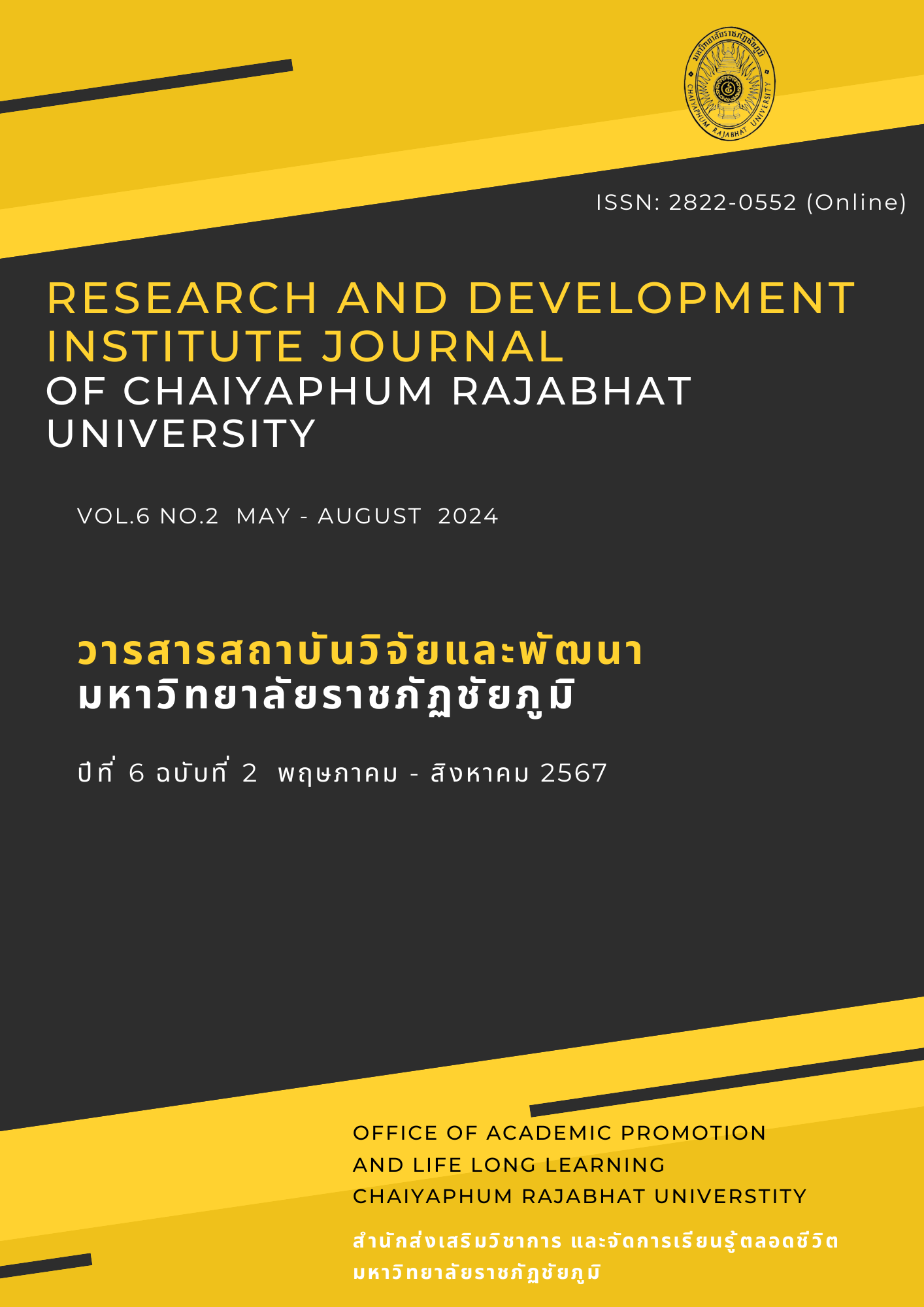The development of causal model factors for the administration of safety school under the pluralistic society in large schools in Office of the Basic Education Commission.
Main Article Content
Abstract
This research, the objectives are to 1) Study the factors of the administration of safety school under a pluralistic society in large schools. 2) Development of causal model factors for the administration of safety school under a pluralistic society in large schools. 3) Confirming the causal model factors for the administration of safety school under a pluralistic society in large schools. This research used mixed methods research. This research was divided into 3 phases as follows: Phase 1 studied documents and interviewed 3 school administrators using by the purposive selection method as specified. The tools used were semi-structured interviews and content analysis. Phase 2 analyse the causal factors of school administration of safety school under a pluralistic society in large schools. The sample used in the research included administrators and teachers who were responsible for taking care of educational institutions in the Office of the Basic Education Commission, Nonthaburi Province, Phra Nakhon Si Ayutthaya Province, Pathum Thani Province, and Saraburi Province, a total of 519 people, were obtained using a multistage random sampling method. The instrument used was a questionnaire created by the researcher. Statistics used to analyse data include basic statistics and path analysis. Phase 3: Verify the model by 3 experts using by a purposive selection method based on the specified criteria. The tool used for verification is a causal model verification form. Statistics used include frequency, percentage, and content analysis. Results.
- Components of the factors for the administration of safety school under the pluralistic society in large schools, including arranging a safe atmosphere and environment, awareness of safety and campaigns to create attitudes, arranging a welfare education curriculum, arranging a student protection system, arranging safety services and prevention measures and solving problems.
- Causal model factors for the administration of safety school under the pluralistic society in large schools, these include the provision of a safe atmosphere and environment, the provision of safety services, the provision of a student protection system, the provision of a welfare education curriculum, and measures to prevent and solve problems. and campaigns to create attitudes and awareness of safety Each factor is consistent with empirical data when considering CMIN/df = 2.44, p-value=0.02, GFI=0.99, AGFI=0.96, CFI=0.99, NFI=0.99, IFI=0.99, RMR=0.00 and RMSEA is equal to 0.05 By measures to prevent and solve problems, provide security services and organizing a child protection system It has a direct influence on the administration of safe educational institutions under a pluralistic society in large schools. In organizing the atmosphere and environment to be safe. It has an indirect influence through the campaign to create attitudes and consciousness. Through the child protection system to safety in educational institutions. The campaign to create attitude and spirit There is also an indirect influence through organizing the welfare education curriculum. Through the provision of safety services to ensure safety in educational institutions.
- The results confirm the factors of the causal model for the administration of safety school under the pluralistic society in large schools, it was found that the format was appropriate, possible, correct, and could be used at a high level. Experts have given their opinions on the principles of safe school administration. Executives should give importance to assessment to prevent and solve problems in risk areas. Including the determination of measures and serious implementation of safety measures in educational institutions.
Article Details

This work is licensed under a Creative Commons Attribution-NonCommercial-NoDerivatives 4.0 International License.
Permission to use text, content, images, etc. of publication. Any user to read, download, copy, distribute, print, search, or link to the full texts of articles, crawl them for indexing, pass them as data to software, or use them for any other lawful purpose. But do not use it for commercial use or with the intent to benefit any business. Published under a Creative Commons Attribution-NonCommercial-NoDerivatives 4.0 International License.

This work is licensed under a Creative Commons Attribution-NonCommercial-NoDerivatives 4.0 International License
References
กรมป้องกันและบรรเทาสาธารณภัย. (2552). หนังสือการ์ตูนชุด “เรียนรู้สาธารณภัย” ตอน ความปลอดภัยในโรงเรียน. กรุงเทพมหานคร. ฝ่ายผลิตสื่อโสตทัศนูปกรณ์และสิ่งพิมพ์ กองเผยแพร่และประชาสัมพันธ์ กรมป้องกันและบรรเทาสาธารณภัย กระทรวงมหาดไทย.
กนกอร อุ่นสถานนท์. (2563). การบริหารด้านความปลอดภัยของสถานศึกษา สังกัดสำนักงานเขตพื้นที่การศึกษามัธยมศึกษา เขต 2 กรุงเทพมหานคร. [วิทยานิพนธ์ปริญญามหาบัณฑิต]. มหาวิทยาลัยราชภัฏสวนสุนันทา.
กฤษฎา ศรีสุชาติ. (2559). การพัฒนาตัวบ่งชี้และคู่มือโรงเรียนปลอดภัยของสถานศึกษา สังกัดสำนักงานคณะกรรมการการศึกษาขั้นพื้นฐาน. [วิทยานิพนธ์ปริญญาดุษฎีบัณฑิต]. มหาวิทยาลัยราชภัฎมหาสารคาม.
ศิริพร อนุสภา. (2556). ปัจจัยที่มีผลต่อการจัดการความปลอดภัยของนักเรียนชั้นประถมศึกษาโรงเรียนเอกชนในครอบครัวซาเลเซียน. [วิทยานิพนธ์ปริญญามหาบัณฑิต]. มหาวิทยาลัยศรีนครินทรวิโรฒ.
สมจินตนา คำพินิจ, จริยาวัตร คมพยัคฆ์, วนิดา ดุรงค์ฤทธิชัย. (2550). การพัฒนารูปแบบการป้องกันอุบัติเหตุในนักเรียนประถมศึกษาโรงเรียนราชินี. วารสาร มฉก. วิชาการ, 11(21), 1-15
สำนักงานคณะกรรมการการศึกษาขั้นพื้นฐาน. (2556). แนวทางปฏิบัติและมาตรการรักษาความปลอดภัยของสถานศึกษา (ฉบับปรับปรุง พ.ศ. 2556). กรุงเทพฯ: สำนักอำนวยการ กระทรวงศึกษาธิการ.
สำนักงานคณะกรรมการการศึกษาขั้นพื้นฐาน. (2566). จำนวนโรงเรียน นักเรียน ครู/ลูกจ้าง และห้องเรียน จำแนกตามขนาดจำนวนนักเรียน ปีการศึกษา 2566. กรุงเทพฯ: สำนักนโยบายและแผนการศึกษาขั้นพื้นฐาน กระทรวงศึกษาธิการ.
สุวิมล ติรกานันท์. (2553). การวิเคราะห์ตัวแปรพหุในงานวิจัยทางสังคมศาสตร์ (พิมพ์ครั้งที่ 2). กรุงเทพฯ: โรงพิมพ์แห่งจุฬาลงกรณ์มหาวิทยาลัย.
อดิศร ดีปานธรรม. (2561). การพัฒนารูปแบบการจัดการด้านความปลอดภัยแบบมีส่วนร่วมในสถานศึกษา สังกัดสำนักงานคณะกรรมการการศึกษาขั้นพื้นฐาน. [วิทยานิพนธ์ปริญญาดุษฎีบัณฑิต]. มหาวิทยาลัยราชภัฏราชนครินทร์.
อมรวิชช์ นาครทรรพ. (2553). รู้รักษาตน เป็นคนปลอดภัย: แนวคิดและแนวทางการเสริมสร้างสุขภาวะและการเรียนรู้ เรื่องการดูแลความปลอดภัยให้ตนเองและผู้อื่น. กรุงเทพฯ: โรงพิมพ์แห่งจุฬาลงกรณ์มหาวิทยาลัย.
David, P. (2016). Policies, practices, and procedures: A study of Indiana school safety. Doctoral dissertation. Ball State University, Muncie, IN.
Hair, J. F. et al. (2010). Multivariate data analysis (7th ed.). New York: Pearson.
Jaworowski, H. L. (2003). The relationship of organizational health and school safety to student achievement. Doctoral dissertation. The College of William and Mary Williamsburg, Virginia.
Munro, B. H. (2001). Statistical methods for health care research (4th ed.). Philadelphia: Lippincott & Wilkins.
Pollack, I. & Sunderman, C. (2000). Management school (2nd ed.). New York: John Wiley and Sons.
Stevens, J. P. (1996). Applied multivariate statistics for the social sciences (3rd ed.). New Jersey: Lawrence Eribaum Associates.
Tabachnick, B. G. & Fidell, L. S. (2007). Using multivariate statistics (5th ed.). Boston: Pearson Education.
Turki, A., Stewart, R. A., Panuwatwanich, K., & Mohamed, S. (2014, July). Determining the causal relationship among balanced scorecard perspectives on school safety performance: Case of Saudi Arabia. Accident Analysis & Prevention, 68(2), 57-74. https://doi.org/10.1016/j.aap.2014.02.002


